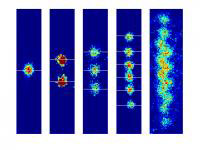New ion trap may lead to large quantum computers

False-color images of 1, 2, 3, 6, and 12 magnesium ions loaded into NIST's new planar ion trap. Red indicates areas of highest fluorescence, or the centers of the ions. As more ions are loaded in the trap, they squeeze closer together, until the 12-ion string falls into a zig-zag formation. Credit: Signe Seidelin and John Chiaverini/NIST
Quantum computers would exploit the unusual behavior of the smallest particles of matter and light. Their theoretical ability to perform vast numbers of operations simultaneously has the potential to solve certain problems, such as breaking data encryption codes or searching large databases, far faster than conventional computers. Ions (electrically charged atoms) are promising candidates for use as quantum bits (qubits) in quantum computers. The NIST team, one of 18 research groups worldwide experimenting with ion qubits, previously has demonstrated at a rudimentary level all the basic building blocks for a quantum computer, including key processes such as error correction, and also has proposed a large-scale architecture.
The new NIST trap is the first functional ion trap in which all electrodes are arranged in one horizontal layer, a “chip-like” geometry that is much easier to manufacture than previous ion traps with two or three layers of electrodes. The new trap, which has gold electrodes that confine ions about 40 micrometers above the electrodes, was constructed using standard microfabrication techniques.
NIST scientists report that their single-layer device can trap a dozen magnesium ions without generating too much heat from electrode voltage fluctuations–also an important factor, because heating has limited the prospects for previous small traps. Microscale traps are desirable because the smaller the trap, the faster the future computer. Work is continuing at NIST and at collaborating industrial and federal labs to build single-layer traps with more complex structures in which perhaps 10 to 15 ions eventually could be manipulated with lasers to carry out logic operations.
Media Contact
All latest news from the category: Physics and Astronomy
This area deals with the fundamental laws and building blocks of nature and how they interact, the properties and the behavior of matter, and research into space and time and their structures.
innovations-report provides in-depth reports and articles on subjects such as astrophysics, laser technologies, nuclear, quantum, particle and solid-state physics, nanotechnologies, planetary research and findings (Mars, Venus) and developments related to the Hubble Telescope.
Newest articles

Bringing bio-inspired robots to life
Nebraska researcher Eric Markvicka gets NSF CAREER Award to pursue manufacture of novel materials for soft robotics and stretchable electronics. Engineers are increasingly eager to develop robots that mimic the…

Bella moths use poison to attract mates
Scientists are closer to finding out how. Pyrrolizidine alkaloids are as bitter and toxic as they are hard to pronounce. They’re produced by several different types of plants and are…

AI tool creates ‘synthetic’ images of cells
…for enhanced microscopy analysis. Observing individual cells through microscopes can reveal a range of important cell biological phenomena that frequently play a role in human diseases, but the process of…





















